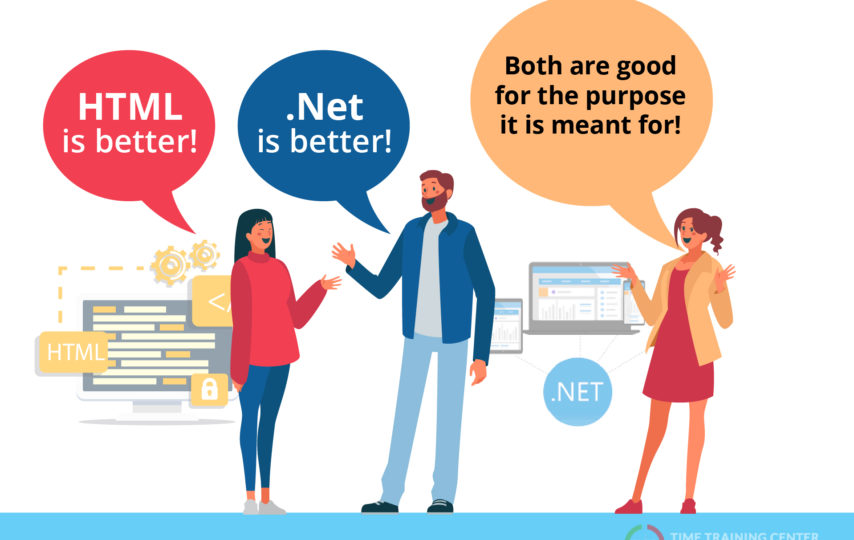There are plenty of computer frameworks and languages which a developer can use to develop web pages or applications. But, when you are considering whether to choose between .NET and HTML, I cannot answer you with a one-word but need to consider many things. As both .NET and HTML have their own specialities and usages, you can consider both of them based on your need and situation. This blog can help you if you’re considering becoming a .NET developer or wanting to have deep knowledge in effectively using HTML.
Before you begin to explore the better version, it’s worth knowing what these languages are and the difference between both .NET and HTML.
What is .NET?
.NET is known as a general-purpose development platform. It’s a framework and not a programming language. It is a product of Microsoft and supports various Microsoft languages such as VB & C#. You can use multiple languages, editors, and libraries with .NET to build native applications for web, desktop, mobile, gaming, and IoT for Windows, Android, Mac OS, Linux, and more. C# is majorly used when a developer wants to develop desktop and mobile web development including cross-platform mobile applications.
What is HTML?
HTML is a core technology markup language of the Internet and a product of World Wide Web Consortium (W3C). It is used for structuring and presenting content for the World Wide Web. In October 2014 HTML5 was released as the final and complete revision of the HTML standard. Its previous version, HTML 4 was standardised in 1997.
The differences between .NET and HTML
.NET is a general-purpose development platform. It is also a free, cross-platform, open-source developer platform for building different types of applications. HTML has its latest and final version HTML5 which is used as a core technology markup language of the Internet for structuring and presenting content for the World Wide Web.
.NET can be classified as a tool in the “full-stack framework category, while HTML5 can be grouped under “Languages”.
There some key factors when developers consider .NET such as a Stable code, Tight integration with visual studio, and the Great community. Whereas, HTML is favoured due to its Local Storage capacity, New doctype, and Canvas. .NET is the favoured open-source tool with GitHub community.
Many popular companies prefer .NET and HTML for their applications development. Some of the popular companies using .NET are Starbucks, Stack Exchange, and Duckboard. While companies like Disqus, Asana, 9GAG use the updated HTML standard version.
In order to choose between both the languages, you need to better understand them. Features are helpful in better defining them.
Features of HTML
- Easy to Understand: HTML is known to be a very easy and simple language. Even those who don’t have a technical background do not find difficulty in understanding it. Therefore, it is easy to be understood and modified.
- Easy to Format: When you want to make an effective presentation, it is easy to be done with HTML as it has a lot of formatting tags.
- Flexible: HTML is a markup language, and so it can be flexibly used to design web pages along with the text.
- Link Enhancement possible: HTML enhances the interest of browsing of the user when programmers add a link on the web pages.
- Multiple-Platform: HTML can be displayed on any platform like Windows, Linux, and Macintosh, etc. and therefore it is platform-independent.
- Media Add-ons: HTML can make your web pages attractive and interactive by adding Graphics, Videos, and Sound in them.
- Case-Insensitive: With HTML you can use tags either in lower-case or upper-case which makes this language case-insensitive.
Features of .NET
- Multi-Platform Support: Whether you want to use .NET with mobile, embedded systems, operating systems or web browser plug-ins, it supports all these platforms.
- Used with various languages: NET is a software development platform that is used in various languages such as C#, VB, J#, etc.
- Interoperable with many languages: HTML provides interoperability with many programming languages which enable each language to be used in other languages.
- Framework Class Library (FCL): Dot net structure has a huge Framework Class Library which provides the system functionality in the Framework as it has various classes, data types, interfaces, etc.
- Architectures: The architectures of the .NET framework include Common Language Runtime (CLR), Common Language Infrastructure (CLI), Assemblies, Class Library, and app models.
- Manageable Code: The code in the .net framework is manageable.
- Microsoft Visual Studio IDE: Microsoft Visual Studio is used as an IDE to develop .NET framework applications.
- DOT NET is language-independent.
- It offers programmers the type of security they needed when using them.
- It is portable
- Offers good memory management
- Better performance
- Provides an automatic garbage collector
- Provides tools to develop, execute, and deploy.
- Offers Scalability
Every language and framework has its own advantages and disadvantages. Similarly, .NET and HTML to have some PROS and CONS suggested by experienced developers. Let’s look into it deeply.
PROS Of .NET
- Tight integration with visual studio
- Stable code
- Great community
- Reliable and strongly typed server-side language.
- Microsoft Support
- Offers fantastic documentation
- Great 3rd party libraries
- Speedy performance
- Great azure integration
- Great support
- Highly productive
- Great programming languages (C#, VB)
- High Performance
- Open-source
- Clean markup with razor
- Powerful Web application framework (ASP.NET MVC)
- Powerful ORM (Entity Framework)
- Constantly improving to keep up with new trends
- Integrated and Reliable
- Huge ecosystem and communities
- Default Debugging tools
- Entity framework
Pros of HTML5
- Semantic Header and Footer, Geo-location, New Doctype
- Local storage
- Canvas
- Video element
- Form autofocus
- Email inputs
- Editable content
- Application caches
- Cleaner Code
- Easy to use
- Modern
- Web sockets
- Compatible
- Content-focused
- Portable
- Have audio elements
CONS of .NET
- .NET is too expensive to deploy and maintain
- .NET operates only on Microsoft dependable systems
- .NET has a hard learning curve
Cons of HTML5
- The dynamic functionality in HTML needs external language support.
- Logic in HTML is invalid as you have to stick to the given structures.
- Some older browsers do not easily support new features and adaptation will be slow.
Let’s Conclude
.NET framework is commonly used by developers and programmers in prominent companies such as Dell, Accenture, TCS, HCL, etc. As ASP .NET is part of .NET, you will find plenty of possibilities and a lot of career and development. Organizations, which mostly use .NET for creating cross-platform applications, are more efficient and versatile. The future career of ASP.Net high for .Net professionals.The industry offers promising opportunities worldwide for youngsters. The user-friendly interface improves the .net platform and makes it one of the best products to use. HTML stands for Hypertext Mark-up Language which is used for developing web pages design. So, are you clear which one to choose between .NET and HTML? Then, be ready to take your next step in your development journey?
Author Profile
Sharafudheen Mangalad
Sharafudheen Mangalad is the managing director of a chain of educational institutions in the UAE. With more than 10 years of experience in the education industry, he successfully runs Edoxi Training Institute in Dubai and Time Training Center Abu Dhabi.
He is a strategist and a leader able to steer the company to the most profitable direction while also implementing its vision, mission and long term goals. He always makes sure that his business continues to grow by identifying, developing and implementing the new strategies. He leads his team in alignment with the company’s vision and values while preparing and implementing comprehensive business plans to facilitate achievement.








